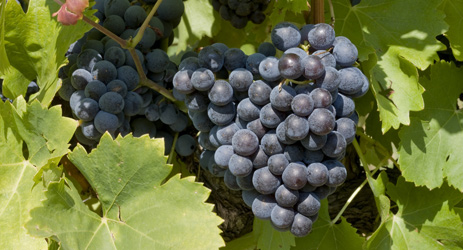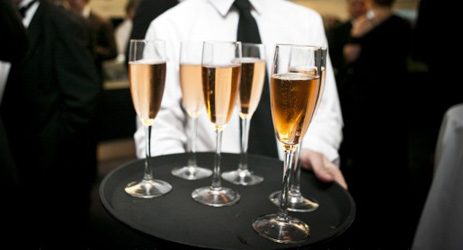If anywhere can be described as the epicentre of Bordeaux rosé, it just might be Chateau de Sours, a sprawling chateau hidden down an unassuming lane in the Entre deuxMers village of Saint Quentin de Baron. The remains of a Roman road pass under parts of the property, while another corner once held an inn on the Medieval pilgrims route, offering solace to the faithful as they trudged piously onwards to Saint Jacques de Compostelle. And it was here, on these limestone hills, that Bordeaux’s rosé revolution was kick-started with the delicate, floral, salmon pink Chateau de Sours Rosé; a wine that made the traditionally raspberry-coloured, more tannic clairet style of Bordeaux rosé seem somehow clunky and old-fashioned. Today its barrel-fermented rosé is the only one on the wine list year-round at the Tate Modern and Tate Britain art galleries, and at the Sydney Opera House. And a sparkling version has created a second revolution in Bordeaux, revitalising a sparkling sector that had almost been abandoned in the region.

All of which means that I was rather surprised to hear owner Martin Krajewski explain why he intends to diversify away from rosé over the coming years in favour of increasing his production of red and white wine. It’s seems even more surprising as I have just been reading about Bordeaux rosé sales growing 36% over the past three years. The French drink a staggering one-third of global supply of rosé, but their main preference to date has been the pale, delicate hues of Provence, so the potential for Bordeaux producers to grab more home market share is clear.
For a traditional red wine region such as Bordeaux, it is in theory super easy to make the switch to rosé production. Certainly if it is made in the traditional way (through a bleeding off, or saignée, of the red wine during its first few hours or days of life, while the juice is still lightly coloured) rosé is easy to produce, and offers the added benefit of concentrating flavours in the red that is left behind. But the sudden glut is not necessarily such good news for producers who grow grapes specifically to produce rosé as a high-quality standalone wine and not as a sideshow to the red.
‘Chateau de Sours rosé is the flagship,’ says Krajewski. ‘We sell everything we produce and it’s ideal for cash flow, but with rosé there is a pressure to ensure that it is all out the door by the end of the year. Up until 2010 the vast majority of our production was rosé because we had done so much replanting but as the plots age we have more flexibility. Competition is huge in Bordeaux right now – and not just here, but globally countless producers are switching over to rosé, more than keeping up with the rise in demand. The competition is phenomenal, and I am very conscious of ensuring we balance supply and demand, because I only make rosé from vines that are specifically intended for that style.’ He pauses, before adding what I suspect is a reason closer to his heart. ‘And we are in Bordeaux, it’s important to produce a high quality red wine’. Krajewski, a British businessman and art collector who founded a successful recruitment company and has sunk much of the proceeds of its sale into de Sours, took over as sole owner in 2004, having been previously a minority shareholder. He inherited a chateau with an enviable reputation for its flagship wine, but which on closer inspection had been allowed to drift.

‘I worked for 35 years in the City of London, 25 of them running my own business, and in the whole time I worked maybe five weekends. Since I came to de Sours, I haven’t had a single weekend off. This is seven days a week, 24 hours a day, 365 days a year. I live not just above the shop but in the shop.’ He pauses, his face somewhere in the vicinity of a smile. ‘I never imagined it would be like this, but I never imagined that it would give me so much pleasure’.
Krajewski has basically spent the last ten years remaking the chateau from top to bottom, inside and out, and listening to how he did it is invigorating. He hates writing things down, having suffered from dyslexia as a child, but has an astonishing ability to make numbers work. When he took over in 2004, the production split was 60% rosé, 30% red and 10% white. Today, although he has more than doubled overall production from 250,000 to 600,000 bottles, the split is 35% rosé, 8% sparkling rosé, 37% red and 20% white. And where the wine was almost entirely sold into the UK market back in 2004, today it goes into 26 different countries, all sold direct.
‘Of the original vines from when I arrived,’ Krajewski says, ‘only one plot has not been replanted, and I am constantly looking to buy more. We are at 55 hectares of our own vines, with a further 30 rented, but ideally, for an estate within AOC Bordeaux, I would like 100 hectares. That’s the sweet spot for seeing economies of scale. And I’d like to end up somewhere around half the production in red wine’.
To achieve that, he has had to adjust his initial plans for the red. ‘I was naive at first, I admit, and didn’t understand how tough it would be to raise individual price point of AOC Bordeaux red. I have upped the density of my plantation to 8,000 vines per hectare, which is around double the usual density for this appellation, and enlisted the help of consultants to get the best out of our limestone terroir. As a result we have maintained the prices on all our wines, while many of our neighbours have seen their prices drop, but expanding production is an easier way to increase profit than raising the ex-chateau price. Alongside that we have focused on creating new styles, and slowly convincing customers, face to face, that our quality is worth it’.

Among his many successes has been adding old vine, barrel-fermented red, white and rosé wines, called La Source, to his normal Chateau de Sours range, as well as the introduction of the sparkling rosé. Not an AOC Crémant, as the local regulations suggest, but simply a Vin de France Sparkling Rosé, made according to the traditional method of a secondary fermentation in bottle, and left on the lees for three years before release. Today he makes 80,000 bottles of this and it has created a whole new category of wine for the estate. This, together with the purchase of a boutique Saint Emilion chateau called Clos Cantenac (‘a tenth of the work and six times the profit’ he says), have created a sense of energy and momentum around the entire range. And you get the feeling that he’s not going to stop until he achieves a similar reception for his red as he has long received for his pink.
‘I came here initially with a plan for a five-year turnaround before selling the chateau on. That quickly became a ten-year plan, and now who knows… I hope my children will take over after me. This has become part of me now, and all bets are off’.
The Wine…
La Source du Chateau de Sours rosé, AOC Bordeaux 2012
Strikingly dry, and as is often the case with barrel-aged rosé, there are delicate aromas of orange zest and roses. Good structure, and very fresh, beautiful pale colour without compromising on flavour. The floral touches give a fine lift on the finish. 91. Highly recommended. Drink now to 2016.

Columnist Introduction
Jane Anson is Bordeaux correspondent for Decanter, and has lived in the region since 2003. She is author of Bordeaux Legends, a history of the First Growth wines (October 2012 Editions de la Martiniere), the Bordeaux and Southwest France author of The Wine Opus and 1000 Great Wines That Won’t Cost A Fortune (both Dorling Kindersley, 2010 and 2011). Anson is contributing writer of the Michelin Green Guide to the Wine Regions of France (March 2010, Michelin Publications), and writes a monthly wine column for the South China Morning Post in Hong Kong, where she lived from 1994 to 1997. Accredited wine teacher at the Bordeaux Ecole du Vin, with a Masters in publishing from University College London.
Click here to read all articles by Jane Anson>>
- Follow us on Weibo @Decanter醇鉴 and Facebook
and Facebook for most recent news and updates -
for most recent news and updates -
All rights reserved by Future plc. No part of this publication may be reproduced, distributed or transmitted in any form or by any means without the prior written permission of Decanter.
Only Official Media Partners (see About us) of DecanterChina.com may republish part of the content from the site without prior permission under strict Terms & Conditions. Contact china@decanter.com to learn about how to become an Official Media Partner of DecanterChina.com.






Comments
Submit